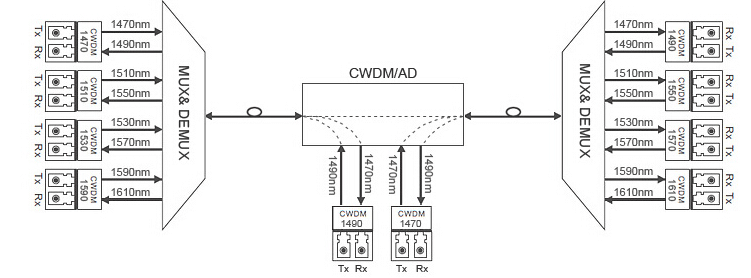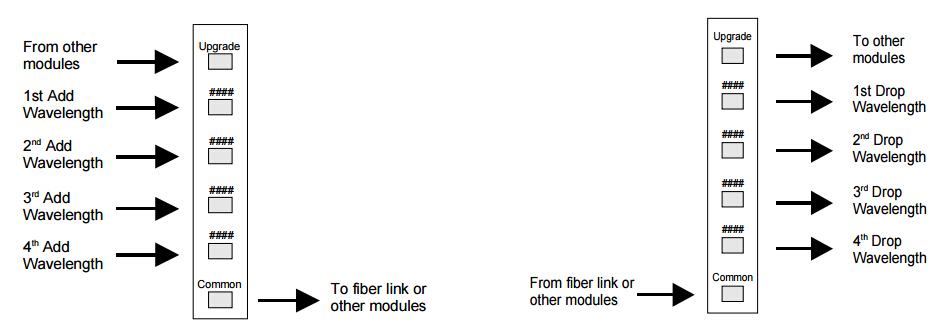Advanced networking technologies bring more convenience and flexibility to our lives, as well as the never-ending demand for higher bandwidth and faster transmission rates. To meet these requirements, service providers and network managers are more inclined to seek help from fiber optics. However, as available fiber infrastructure is restricted and to add more fiber is no longer a feasible and economical option, it is hence vital to search for more cost-effective methods to enhance network capacity. Wavelength-divison multiplexing (WDM) is a technology which multiplexes multiple optical signals onto a single fiber by using different wavelengths or colors of light. This technology can greatly reduce the cost of increasing network capacity without having to move a single shovelful of dirt or hang a single new fiber. This article mainly talks about CWDM.
There are two types of WDM implementations: dense wavelength division multiplexing (DWDM) and coarse wavelength division multiplexing (CWDM). In the following part, we will introduce CWDM Mux/Demux solutions for promoting network capacity.
CWDM Mux/Demux, short for coarse wavelength division multiplexing multiplexer/demultiplexer, has proved to be a flexible and economical solution which allows for expanding the existing fiber capacity effectively. It enables operators to make full use of available fiber bandwidth in local loop and enterprise architectures. It can enhance capacity and increase bandwidth to the maximum over a single or dual fiber cable. Hence, by adopting CWDM Mux/Demux to the networking system, you are able to get other independent data links with less fiber cables required. CWDM Mux/Demux modules are wide from 2 channels to 18 channels in the form of 1RU 19’’ rack chassis.

The CWDM Mux/Demux has a long transmission distance coverage of multiple signals on a single fiber strand. It can support various types of signals such as 3Gbps/HD/SD, AES, DVB-ASI, Ethernet, etc. Furthermore, its ambient operating temperature is from -40℃ to 85℃, which means it is also suitable for outside plant applications. Besides, it requires no powering because of the thermally stable passive optics.
Mux/Demux functions to multiplex or demultiplex multiple wavelengths, which are used on a single fiber link. The difference lies in the wavelengths, which are used. In CWDM space, the 1310-band and the 1550-band are divided into smaller bands, each only 20nm wide. In the multiplex operation, the multiple wavelength bands are combined (muxed) onto a single fiber. In a demultiplex operation, the multiple wavelength bands are separated (demuxed) from a single fiber.
In a hybrid configuration (mux/demux), multiple transmit and receive signals can be combined onto a single fiber. Each signal is assigned a different wavelength. At each end, transmit signals are muxed, while receive signals are demuxed. For example, in a simple full-duplex link, the transmit is assigned the 1530nm wavelength, while the receive signal is assigned the 1550nm wavelength.

A CWDM Mux/Demux with up to 18 channels has been introduced to cater for the ever-increasing demand for massive bandwidth and higher capacity. Just as the name indicates, the 18-channel version can combine up to 18 different wavelength signals from different optical fibers into a single optical fiber, or separates up to 18 different wavelength signals coming from a single optical fiber. FS.COM provides 18-CHCWDM Mux/Demux that is equipped with a monitor port, which is designed to ensure better CWDM network management.

This 18-CH CWDM Mux/Demux modules can multiplex and de-multiplex up to 18 CWDM sources over a single fiber with insertion loss below 4.9dB. It features a monitor port which ensures easy troubleshooting without downtime. Which efficiently contribute to expand the bandwidth of optical communication networks with lower loss and greater distance capacities.
In conclusion, CWDM Mux/Demux technology is a very effective method for overcoming fiber exhaust. Employing it in your fiber optic network can greatly increase bandwidth without the need to spend capital on new fiber construction projects. It is hence natural that the technology is considered as a feasible and economical solution to realize network capacity promotion. With this technology, fiber count is no longer a constraint to most service providers and enterprises.




